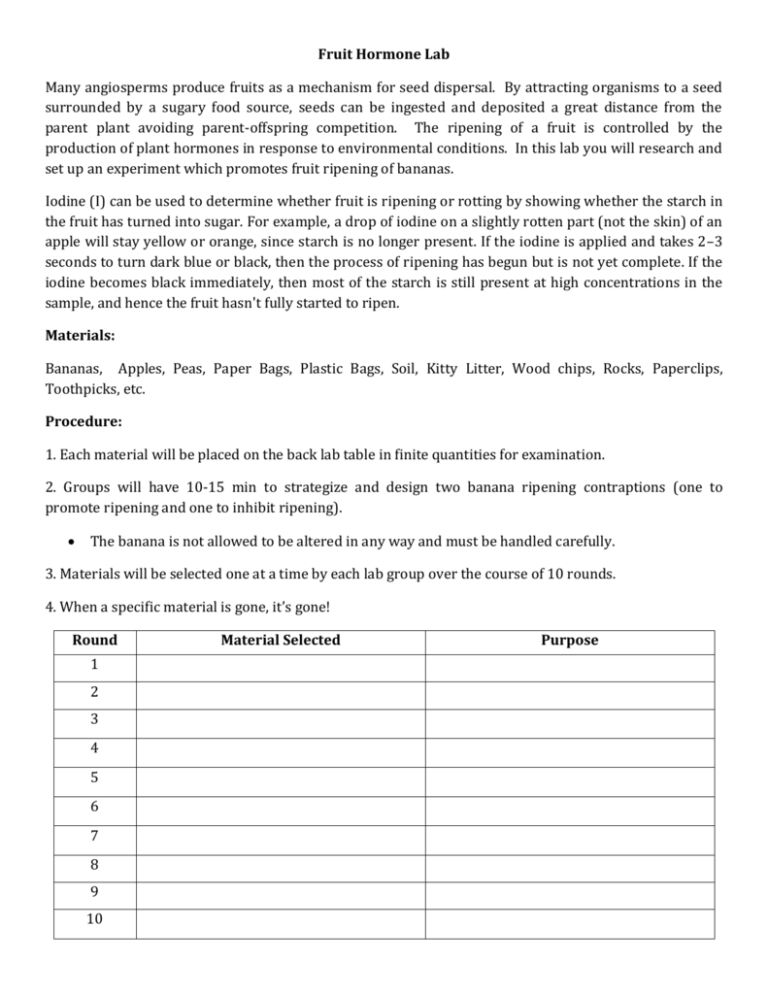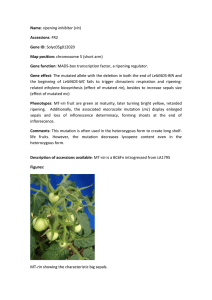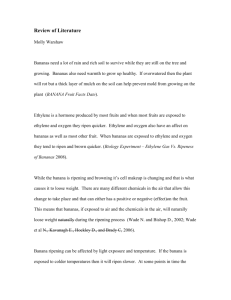Place 1 banana 1 apple and 1 pear in a box where it cant receive any light. Experiment ends once yellow colouration is observed.

Pdf Fruit Ripening And Postharvest Life Of Banana Varieties At Different Temperatures And Packaging
During the process of ripening apples convert stored starch into sugar.

. Examine both bananas 3. Pour the iodine stain into the bottom of the shallow tray so that it fills the tray about half a centimeter deep. Record your observations in your lab notebook.
Ripening softens and sweetens the fruit to make it more palatable. Obtain 5 bananas 5 apples 5 pears a lamp a heater and a box. Allow the fruit to absorb the stain for one minute.
Wrap six of the bananas in a sheet of newspaper and leave the other out in the open. Repeat step 1 and 2 for the lime and grapefruit. You should write your answers into a word processing program and save the file.
SAMPLE PLANNING AND DESIGN LAB Conditions Necessary for Rusting Aim. This project examines the reasons and applications for the ripening of fruits. Place 1 banana 1 apple and 1 pear under the exposure of a lamp.
Plan and design Plan and design Fruit ripening Fruit ripening Statement of. Cut the pear or apple in half cross section and set the fruit into the tray with the cut surface in the stain. Place both containers in an area that is 60 72F room temperature is sufficient.
Fruit Ripening Lab Place a Banana in each container 2. Hypothesis Yellow limes have the highest level of acidity Aim based on procedure used To measure the pH level of lime juice obtained from yellow limes and from green limes this would be appropriate if the procedure involved the use of a pH meter To measure the volumes of standard NaOH solution used in the titration between the NaOH and the lime juice from each. BIOLOGY PLAN AND DESIGN LAB Date.
Read and follow the safety note above step 7. Everyday at the same time check for yellow colouration among the bananas in each bowl. Go into the Lab Report Ripening Bananas and cut and paste the answers to each question in the appropriate space.
Cut the pear or apple in half cross-section and set the fruit into the tray with the cut surface in the stain. If one is riper than the other buy a new banana. The bags without bananas are the control and will show the normal fruit ripening process.
Wear protective gloves eye wear and a lab coat when handling the staining solution. Make sure all bananas are about equally unripe. Up to 24 cash back Place orange on chopping board and slice in half with knife.
Place A into C and fill C with ice up to the level of milk in A and cover with plate. After 24 hours and every 24 hours thereafter remove the lids of the containers to vent. This activity relates to how food is prepared for the Space Shuttle.
After the experiment learners measure the exposed surface area of the foods. Wrap six of the bananas in a sheet of newspaper and leave the other out in the open. Fruit ripening is a developmental process evolved to foster animal-mediated seed dispersal and considerable progress have been made through studies of tomato Solanum lycopersicum which is an important vegetable crop as well as the model plant for the Solanaceae family.
Fruit is a strategy some plants use to attract animals to disperse seeds. Ripening is the process by which fruits become tastier. Squeeze a portion of juice into relevant bowl.
Lay out 3 pH Test Strips one in front of each bowl. They ship better that way and they arrive into a distributors warehouse without bruises. Remove the fruit and rinse the face with water under a faucet is fine.
Pour the iodine stain solution into the glass or plastic tray to a depth of 05 cm. Observe how the pears or apples look. Record the time and day.
Place the cut face of the fruit into the stain. In this activity learners test the rate of ripening fruit and vegetables and use a chemical to inhibit the ripening process. Repeat step 3 over the next two days.
Know is that bananas are shipped to the US as hard green sour unripened fruits. To determine a better range of temperature for storing a glass of milk. Squeeze the rubber top of dropper and dip the tip into the orange juice.
In apples and many other commercial fruit the sweet portion of the fruit evolved as a reward for animal seed dispersers. A glass of milk lasts longer in cold temperatures. Ethylene a ripening agent is a simple hydrocarbon gas H 2 CCH 2.
3 Label the bags A-D using the marker 4 Leave the 4 bags containing fruits for 4 days at room temperature 5 Monitor the fruits once daily after the first day observe for any colour change in the banana and Record observations 6 Repeat step 4 for another 2 days 7 On the fourth day prepare for the testing of starch in the fruit firstly by pouring 5cm3 of iodine solution into the. Fruit ripening may occur while the fruit is still attached to plant as is usual in non-climacteric fruits or after their harvest as in climacteric fruits. Do not open the containers for 24 hours.
Place one ripe banana in two of the baggies and zip all baggies closed. Monitor the ripening of the fruit comparing color changes in the bananas. The ripening of fleshy fruits represents the unique coordination of developmental and biochemical pathways leading to changes in color texture ar-.
Some fruits continue ripening after being picked while other fruits do not. If not consumed in time the ripened fruits begin to rot due to invasion by saprophytic organisms. Allow the fruit to absorb the stain for one minute.
Cut the pear apple in half in cross section. Release and wait for dropper to fill. Thus picking a fruit will sometimes signal it to ripen as will.
Record the data for the fruit then repeat the procedure for the other applespears. 3580 for a 2-page paper Examine both bananas 3. The animals eat the fruit and disperse the seeds through the digestive system.
This will replenish the O 2 and release the CO 2. The pears with the bananas are the test. Climacteric and Non-climacteric Fruits and Role of Ethylene in Fruit Ripening.
Lab Report Ripening Bananas can be found on the Content page or under Assignments Quizzes The data table for Question 1 will be. When seeds are ripe and ready for dispersal the fruit converts stored starch which does not taste sweet into sugar. Record the time and day.
Everyday at the same time check for yellow colouration among the bananas in each bowl. Once they reach the warehouse the bananas are allowed to ripen by the addition of a small amount of ethylene. 2-100cm3 beakers 2-500cm3 beakers Milk Ice Hot water Marker Method.
Place both containers in an area that is 60 72F room temperature is sufficient. Stain the Fruit 1. Fruit ripening is a highly coordinated developmental processes which is accompanied by number of biochemical changes such as tissue softening color changes volatile production reduction of astringency taste seed maturation and many others Maduwanthi Marapana 2019.
This preview shows page 1 - 2 out of 2 pages. To attract animals fruit needs to ripen and develop an odor that acts as an attractant. Syllabus Topic.

Doc Bio P D Iplementation Ejon Thomas Academia Edu

Fruit Ripening Pdf Plant Hormone Ethylene

Plan And Design Lab Number 2 Doc Experiment No 2 Hypothesis The Gas Ethylene Which Is Emitted Causes Ripening Storing Fruits And Vegetables Together Course Hero





0 comments
Post a Comment